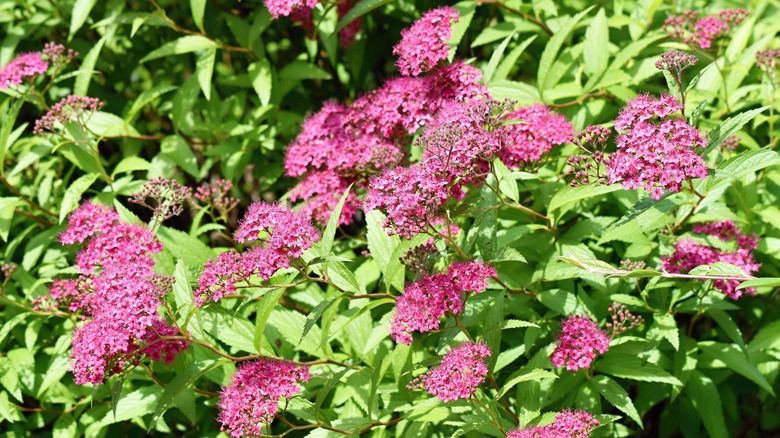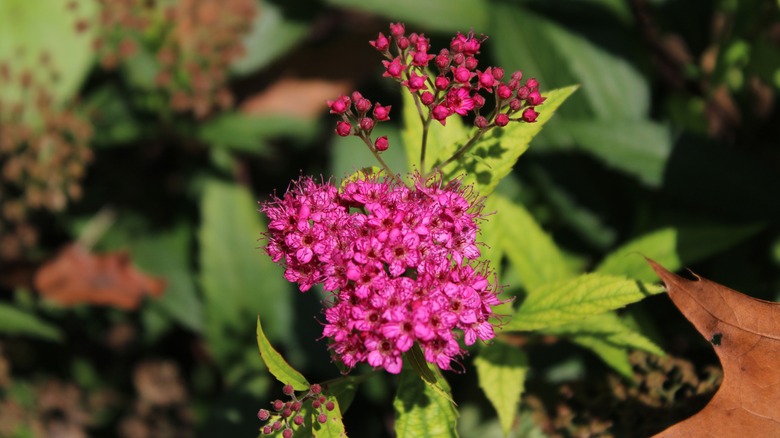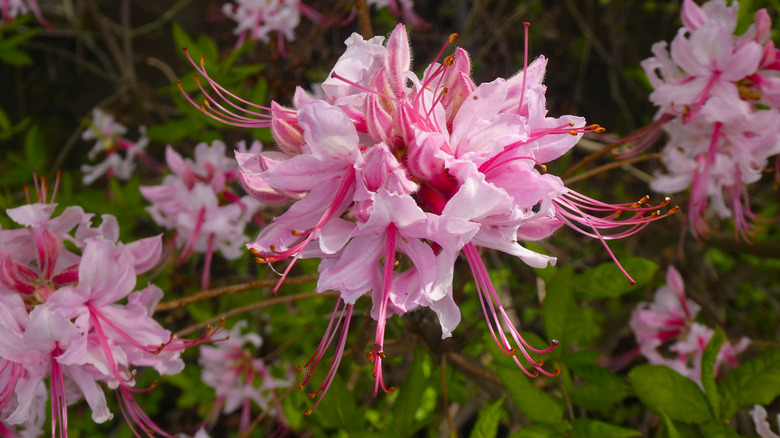Beautiful Native Plants To Grow Instead Of Invasive Spirea
Bright pink flowers that are a magnet for pollinators and easy to grow— what's not to love? While the showy blooms may draw you in, Japanese spirea (Spiraea japonica) is an invasive species that can quickly take over your garden and disrupt local ecosystems. Native to eastern Asia, one of these shrubs can produce hundreds of seeds, which can live in the soil for years, leading to the spread of new plants. If not controlled, the new shrubs can outcompete and replace the native plants in an area, reducing biodiversity. Because of its quick-spreading nature, Japanese spirea is considered invasive in several states, including Tennessee, Kentucky, Georgia, and South Carolina.
Thankfully, there are several native alternative shrubs to consider that will look stunning in your garden without the drawbacks. There are even a few non-invasive options within the spirea genus, like rose meadowsweet (Spiraea splendens) and white meadowsweet (Spiraea alba). You can also brighten your garden with other species of pink-flowering native shrubs like pink honeysuckle (Lonicera hispidula), mountain laurel (Kalmia latifolia), and pink azalea (Rhododendron periclymenoides). Let's discuss some of the best Japanese spirea alternatives for your garden.
Rose meadowsweet is a non-invasive family member
If you're searching for a native alternative to the invasive Japanese spirea, you can't get much closer than its relative, rose meadowsweet (Spiraea splendens). Displaying fragrant, bright pink flower clusters in summer and offering year-round interest, this hardy shrub provides a stunning focal point in any garden. Not only are the fuzzy-looking blooms pleasing to the eye, but they also bring in more pollinators to your yard, helping to promote a thriving habitat for bees and butterflies. When summer shifts to fall, the bright green leaves fade into a golden yellow, giving your landscape a splash of autumnal color.
Rose meadowsweet may be low-maintenance, but it's not without its preferences. It thrives in moist to wet soils, making it a perfect addition to a rain garden. However, while it likes consistent moisture, the soil should also be well-drained to prevent waterlogging. Hardy in zones 5 through 8, this shrub prefers plenty of sunshine but can also tolerate some shade. To keep your shrub looking its best, promptly remove any dead blooms to make room for new growth. When the weather cools down in the fall and winter months, prune the branches to encourage a fuller, more vibrant display come spring. With the proper care, you can expect rose meadowsweet to grow about 2 to 3 feet tall and wide.
Opt for pink azalea for clusters of showy pink blooms
Pink azalea (Rhododendron periclymenoides) is a flowering plant that's a gardening must for hummingbird lovers. This shrub features large clusters of pink or white cone-shaped blooms with long, attractive stamens protruding from the center. Its flowers appear first, and its dark green leaves arrive afterward. In autumn, the foliage turns to a faded yellow shade before dropping in winter. Although the autumn colors aren't as exciting as those in spring or summer, the horizontal branches look pretty with a light dusting of snow. That said, strong winter winds can be damaging, so it should be planted in a protected area.
To grow this flowering shrub in your garden, choose a site that's organically rich, acidic, and humusy. Well-drained soil is a must as pink azalea has a shallow root system, making it susceptible to root rot. However, it still requires plenty of hydration, so thoroughly saturate the soil to make sure it travels down to the roots. Younger plants require more regular watering, but they'll need less and less as they become more established. Preferring part shade, you can grow Rhododendron periclymenoides in hardiness zones 4 through 9. Pink azalea is a medium-sized shrub that can grow up to 15 feet tall but usually stays under 6 feet. A low-maintenance plant, you won't need to worry about pruning aside from removing spent flowers. It's important to note that all parts of this plant are poisonous to humans, dogs, cats, and horses.


